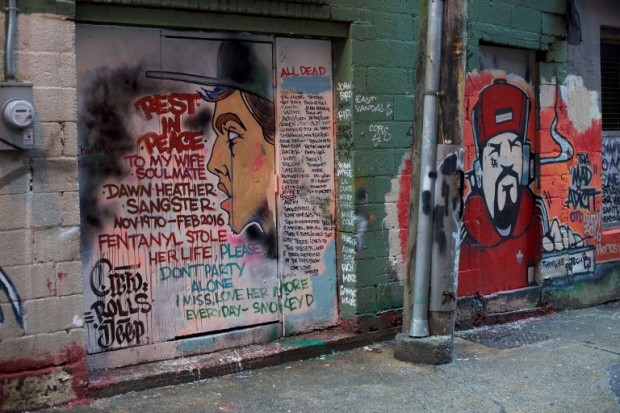
A mural in an alley in Vancouvers Downtown Eastside, on December 21, 2016, painted by a man mourning the fentanyl overdose death of his wife, with names of other victims of the crisis that killed 128 people in British Columbia in November. AFP
VANCOUVER, Canada — Sirens scream non-stop through the urban heart of Vancouver, as responders race toward drug addicts overdosing — and dying in such numbers that the city’s morgues are full.
This wealthy Pacific coast city is the bleak epicenter of an opioid epidemic that has claimed thousands of lives in Canada, while next door in the United States, drug overdoses are now the leading cause of accidental death.
READ: Baby exposed to fentanyl stops breathing
“There’s not a single person down here that’s chosen to be a junkie,” said Martin Steward, a self-admitted drug user who manages a treatment facility in Vancouver’s gritty Downtown Eastside neighborhood where the crisis is concentrated.
“Something happened in their lives: emotional, mental, physical, that brought them to where they are.”
On the neighborhood’s Hastings Street, blocks that were once bustling with people are now emptier.
“There are less and less of the people I know here,” said Mary Mootrey, who has lived in the area for 25 years, pointing to a few milling around. “They’ve all overdosed.”
Authorities in British Columbia predict that 2016 will break all records for provincial deaths from opioid overdoses, including 128 in November alone.
READ: Fentanyl deadlier than heroin
Officials had first declared an emergency in the spring, as cheap synthetic fentanyl replaced expensive heroin and soon became mixed into most street drugs.
A pill sells for as little as Can$2 (US$1.50), said the 59-year-old Mootrey.
“I wish they’d all go into treatment,” she said of the many addicts in her neighborhood.
But treatment facilities are full, with long waits to get a spot.
“There’s always been a problem here,” said Steward, who manages a facility run by the Vancouver Area Network of Drug Users.
“But now the morgue’s full, they look at it and say, we better do something.”
The 44-year-old has personal experience with addiction: a cocaine user by age 12, he eventually found himself living on the streets in Montreal.
Steward said he now uses cocaine and heroin, taking care to buy only from a known dealer and never injecting alone, in case he overdoses.
Skid Row
For decades, the Downtown Eastside, or DTES, was where men broken by Canada’s resource booms ended up in cheap hotels, each with a pub on the ground floor.
Over time, they were joined by drug addicts from across Canada, and the mentally ill left homeless when British Columbia closed mental health institutions without providing community housing as promised.
“A lot of people here are under care, and targeted by drug dealers,” said Neil Arao, manager of Insite, North America’s only supervised injection site, located in the DTES.
He estimated at least 1,200 locals are both mentally ill and addicted to drugs, though there are no accurate numbers.
Proposed solutions range from decriminalizing hard drugs to prescribing heroin to adding rehabilitation facilities.
Long term, experts and advocates agree, the solution is to reduce the numbers of drug users by solving issues that begin, for most, in childhood.
That’s a challenge compounded by British Columbia’s child poverty rate of about 20 percent, one of the highest in North America.
‘Like a trap’
The acute poverty and despair in the DTES is a shocking sight in the heart of Vancouver, an otherwise bustling and wealthy metropolis where average home prices are nearly Can$1 million, according to the Canadian Real Estate Association.
It is “like a trap,” said Arao. “It’s hard to escape it.”
The numbers are stark. The Insite supervised injection center serves about 700 drug users a day, Arao said. In the past, one or two overdosed each day but in recent weeks it’s up to 15 per day.
The emergency room at St. Paul’s hospital has handled more than 6,000 overdose patients so far this year, said physician Nadia Fairbairn.
“Vancouver is right in the middle of the crisis,” she said.
It is “like a trap,” said Arao. “It’s hard to escape it.”
In December, officials launched a mobile overdose clinic in the Downtown Eastside, staffed by emergency and addiction physicians.
Agencies have also set up rooms, and even tents in alleys, staffed by trained volunteers equipped with some 18,000 kits distributed by the government.
Each contains injectable naloxone, which quickly counters the effect of most opioids.
Most policy experts agree there is little prospect for stopping the supply of cheap synthetic opioids. Authorities say most are shipped from China, and mixed in Canada with other drugs or pressed into pills.
Synthetic opioids are also available on the internet, with sites advertising discreet mail order shipments.
Asked to describe the situation, Arao said to call it a “crisis” implies there will be an end.
“I’m wondering if this is now our normal,” he said. CBB